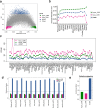Analyses of inter-individual variations of sperm DNA methylation and their potential implications in cattle
- PMID: 31752687
- PMCID: PMC6873545
- DOI: 10.1186/s12864-019-6228-6
Analyses of inter-individual variations of sperm DNA methylation and their potential implications in cattle
Abstract
Background: DNA methylation has been shown to be involved in many biological processes, including X chromosome inactivation in females, paternal genomic imprinting, and others.
Results: Based on the correlation patterns of methylation levels of neighboring CpG sites among 28 sperm whole genome bisulfite sequencing (WGBS) data (486 × coverage), we obtained 31,272 methylation haplotype blocks (MHBs). Among them, we defined conserved methylated regions (CMRs), variably methylated regions (VMRs) and highly variably methylated regions (HVMRs) among individuals, and showed that HVMRs might play roles in transcriptional regulation and function in complex traits variation and adaptive evolution by integrating evidence from traditional and molecular quantitative trait loci (QTL), and selection signatures. Using a weighted correlation network analysis (WGCNA), we also detected a co-regulated module of HVMRs that was significantly associated with reproduction traits, and enriched for glycosyltransferase genes, which play critical roles in spermatogenesis and fertilization. Additionally, we identified 46 VMRs significantly associated with reproduction traits, nine of which were regulated by cis-SNPs, implying the possible intrinsic relationships among genomic variations, DNA methylation, and phenotypes. These significant VMRs were co-localized (± 10 kb) with genes related to sperm motility and reproduction, including ZFP36L1, CRISP2 and HGF. We provided further evidence that rs109326022 within a predominant QTL on BTA18 might influence the reproduction traits through regulating the methylation level of nearby genes JOSD2 and ASPDH in sperm.
Conclusion: In summary, our results demonstrated associations of sperm DNA methylation with reproduction traits, highlighting the potential of epigenomic information in genomic improvement programs for cattle.
Keywords: Cattle; Methylation haplotype blocks; Reproduction traits; Sperm DNA methylation; Variably methylated regions.
Conflict of interest statement
The authors declare that they have no competing interests except that George Liu is a member of the editorial board (Associate Editor) of this journal.
Figures






Similar articles
-
Comparative whole genome DNA methylation profiling of cattle sperm and somatic tissues reveals striking hypomethylated patterns in sperm.Gigascience. 2018 May 1;7(5):giy039. doi: 10.1093/gigascience/giy039. Gigascience. 2018. PMID: 29635292 Free PMC article.
-
Intergenerational impact of paternal lifetime exposures to both folic acid deficiency and supplementation on reproductive outcomes and imprinted gene methylation.Mol Hum Reprod. 2017 Jul 1;23(7):461-477. doi: 10.1093/molehr/gax029. Mol Hum Reprod. 2017. PMID: 28535307 Free PMC article.
-
Genomic regions and biological pathways associated with sex-limited reproductive traits in bovine species.J Anim Sci. 2024 Jan 3;102:skae085. doi: 10.1093/jas/skae085. J Anim Sci. 2024. PMID: 38545844 Free PMC article.
-
Analysis of gene-specific and genome-wide sperm DNA methylation.Methods Mol Biol. 2013;927:451-8. doi: 10.1007/978-1-62703-038-0_39. Methods Mol Biol. 2013. PMID: 22992936 Review.
-
On the origin of sperm epigenetic heterogeneity.Reproduction. 2016 May;151(5):R71-8. doi: 10.1530/REP-15-0436. Epub 2016 Feb 16. Reproduction. 2016. PMID: 26884419 Review.
Cited by
-
Unraveling the Genetic Basis of Feed Efficiency in Cattle through Integrated DNA Methylation and CattleGTEx Analysis.Genes (Basel). 2023 Nov 24;14(12):2121. doi: 10.3390/genes14122121. Genes (Basel). 2023. PMID: 38136943 Free PMC article.
-
Harnessing male germline epigenomics for the genetic improvement in cattle.J Anim Sci Biotechnol. 2023 Jun 6;14(1):76. doi: 10.1186/s40104-023-00874-9. J Anim Sci Biotechnol. 2023. PMID: 37277852 Free PMC article. Review.
-
Impacts of Epigenetic Processes on the Health and Productivity of Livestock.Front Genet. 2021 Feb 23;11:613636. doi: 10.3389/fgene.2020.613636. eCollection 2020. Front Genet. 2021. PMID: 33708235 Free PMC article. Review.
-
Coordinated alternation of DNA methylation and alternative splicing of PBRM1 affect bovine sperm structure and motility.Epigenetics. 2023 Dec;18(1):2183339. doi: 10.1080/15592294.2023.2183339. Epigenetics. 2023. PMID: 36866611 Free PMC article.
-
Differentially methylated CpG sites related to fertility in Japanese Black bull spermatozoa: epigenetic biomarker candidates to predict sire conception rate.J Reprod Dev. 2021 Apr 21;67(2):99-107. doi: 10.1262/jrd.2020-137. Epub 2021 Jan 14. J Reprod Dev. 2021. PMID: 33441501 Free PMC article.
References
MeSH terms
Grants and funding
LinkOut - more resources
Full Text Sources
Other Literature Sources

